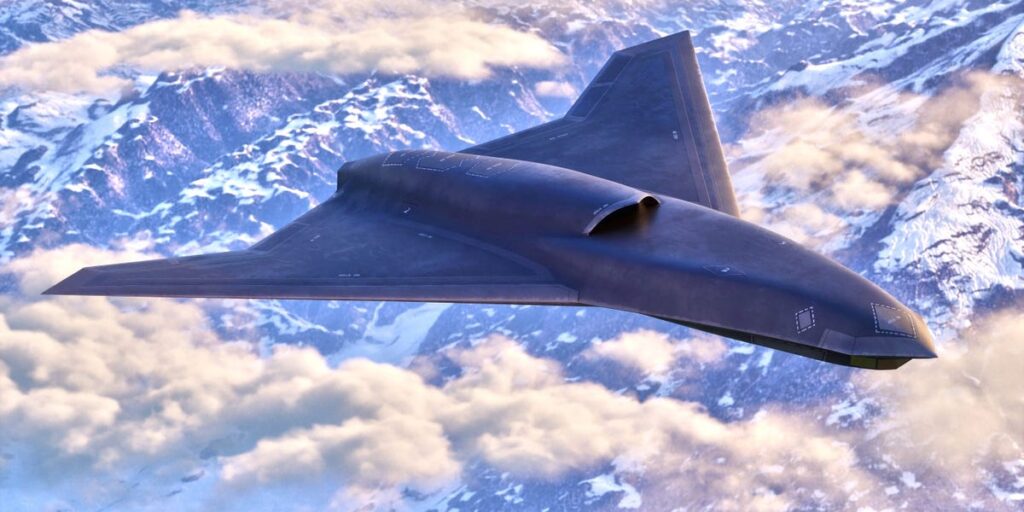A US defense giant behind top stealth combat aircraft has a new one coming, just without a human in the cockpit.
Lockheed Martin introduced the company’s latest project, known as “Vectis,” on Sunday ahead of the annual Air & Space Force Association’s Air, Space and Cyber Conference.
The aircraft is a “Group 5 survivable and lethal collaborative combat aircraft,” the company said in a press release, referring to the largest size of uncrewed aerial systems, or UAS, built to survive enemy defenses and strike back.
“Vectis is the culmination of our expertise in complex systems integration, advanced fighter development and autonomy,” said OJ Sanchez, the vice president and general manager of Lockheed Martin’s Skunk Works, said, adding that the defense firm is “creating a new paradigm for air power based on a highly capable, customizable, and affordable agile drone framework.”
Drones fighting alongside piloted jets
US Air Force artwork courtesy of General Atomics Aeronautical Systems, Inc. and Anduril Industries
It’s a collaborative combat aircraft, or CCA, a type of new “loyal wingman” uncrewed system. Pentagon and defense industry leaders hope to see such aircraft flying either alone or teamed with crewed fighter jets, complementing human pilots for missions ranging from air-to-air combat, electronic warfare, and surveillance and reconnaissance. CCA could also perform missions deemed excessively dangerous for human pilots.
Former Air Force Secretary Frank Kendall previously outlined a notional goal of about 1,000 CCAs, based on the idea of pairing two CCAs with 200 of the service’s future Next Generation Air Dominance fighters and two more for 300 F-35s, each. The idea is to boost combat power without fielding more crewed aircraft, decreasing danger to and demand for pilots. CCAs are also significantly less expensive than crewed combat aircraft.
How many CCAs the Air Force ultimately buys remains to be seen. It is still early days. Two front-runners in the CCA program are products from General Atomics and Anduril, the XQ-67A and the Fury, respectively. These drones were given unique fighter drone designations, YFQ-42A and YFQ-44A, earlier this year.
Other CCA-like designs include Boeing’s MQ-28 Ghost Bat, the Kratos XQ-58A Valkyrie, and now the Vectis from Lockheed.
Stealth aircraft
U.S. Air Force photo by Capt. Kip Sumner
As one of the so-called “Primes,” legacy defense industry behemoths, Lockheed has heavily invested in stealth aircraft since the 1970s, when the company’s mysterious “Skunk Works” group developed the first operational stealth aircraft, the F-117 Nighthawk, created to avoid radar detection.
It was the primary contractor, in partnership with Boeing and Pratt & Whitney, for the fifth-generation F-22 Raptor, an expensive air superiority fighter still used today, though production ceased over a decade ago. And it also makes the F-35 Lightning II Joint Strike Fighter, another fifth-generation fighter that the company intends to upgrade with more advanced capabilities for a “fifth-generation plus” version of the aircraft.
Though important to US airpower and as a stepping stone to next-generation capabilities, the advanced stealth aircraft has been notoriously plagued by mismanagement and constantly ballooning costs.
A decision on the NGAD, now known by the designation F-47, the first US sixth-generation fighter, saw Boeing take the win over Lockheed, but the latter is still looking at ways to incorporate its knowledge and designs into other projects.
In announcing the new drone, Lockheed — maker of the early low-observable RQ-170 Sentinel drone — said that Vectis “leverages decades of stealth expertise to deliver best-in-class survivability for a CCA.”
It added that “Skunk Works has decades of experience leveraging speed, altitude, shape, advanced materials and more to keep crewed and uncrewed platforms safe in the most challenging environments to solve the warfighter’s hardest problems.”



